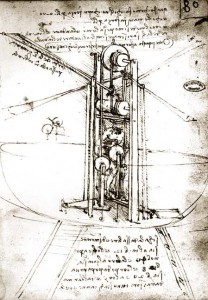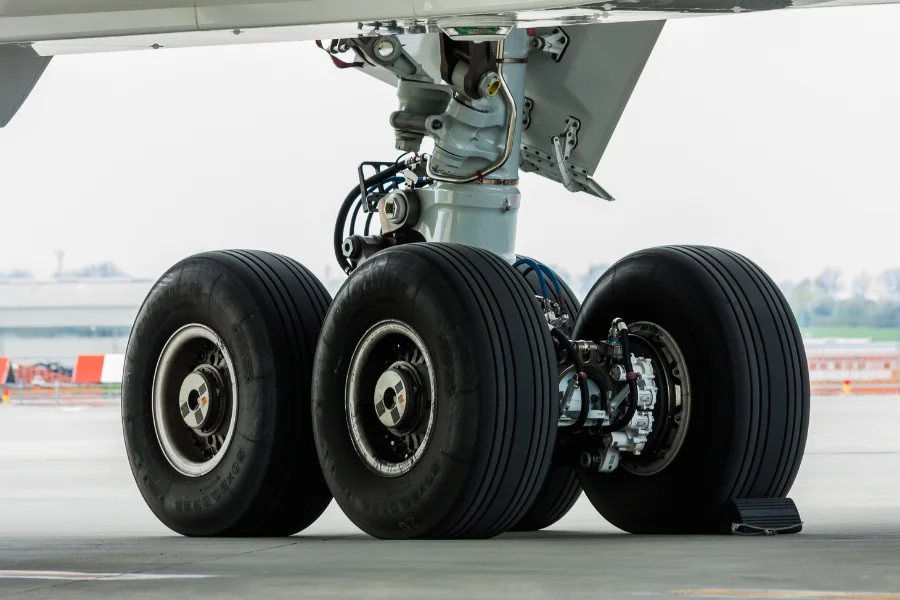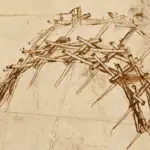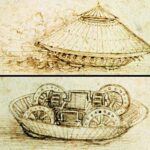
Leonardo da Vinci’s landing gear
Da Vinci Landing Gear remains one of the lesser-known yet fascinating innovations of the Renaissance genius.
He crafted a landing gear system prototype to assist early flying machines in taking off and landing safely.
This invention demonstrates Leonardo da Vinci‘s forward-thinking approach to solving flight challenges when aviation was still a dream.
Exploring the intricacies of his landing gear concept reveals Leonardo’s impressive understanding of mechanical devices.
The design showcased elements intended to reduce shock during landing, highlighting his anticipation of real-world flying conditions.
Current flying machines owe a nod to Da Vinci’s pioneering ideas, which set a foundation for modern aviation technology.
Leonardo’s contributions go beyond painting and sculpture, showcasing his multifaceted genius.
His work on flight, including his landing gear designs, underscores his timeless influence and innovative spirit.
For those who seek to uncover the mind behind these inventions, learning about his landing gear can ignite an interest in history and aviation.
Historical Context of Da Vinci’s Designs
Leonardo da Vinci’s contributions to engineering are profound, reflected in his work on the Da Vinci Landing Gear and other innovative designs. These works showcased his imagination and scientific approach during the Renaissance, making a lasting impact.
Early Sketches and Concepts
Leonardo da Vinci’s early sketches reveal a mind deeply engaged with the mechanisms of flight.
His designs often involved intricate systems of gears and pulleys, exemplified by the Leonardo Da Vinci Landing Gear.
This early concept represents one of the first attempts to tackle the challenge of landing stability in a flying machine.
Although he explored numerous ideas, such as ornithopters and spiral gears, these were mainly theoretical due to the technological limitations of his time.
Da Vinci’s work laid the groundwork for future inventors and remains a testament to his innovative spirit.
His drawings provide valuable insights into how he aimed to make flight feasible long before the Wright brothers succeeded.
Influence on Renaissance Engineering
Da Vinci’s engineering pursuits significantly inspired his contemporaries and future generations.
His use of da Vinci gears and other complex mechanical systems showcased the era’s fascination with blending art with science.
During the Renaissance, a period marked by exploration and innovation, his designs, like the Leonardo da Vinci flying machine, stood out for their detail and ambition.
Though not all his concepts were constructed, they influenced the engineering principles that emerged in later centuries.
His approach bridged the gap between imagination and mechanical reality, demonstrating how art and technology could coexist.
Da Vinci’s legacy in engineering remains influential as a visionary, highlighting the importance of curiosity and creativity in scientific progress.
Overview of Da Vinci Landing Gear
The Da Vinci Landing Gear is an innovative design showcasing Leonardo da Vinci’s mechanical ingenuity. It features unique mechanical principles, specific design specifications, and applications for envisioned flying machines.
Mechanical Principles
Da Vinci’s Landing Gear utilized concepts such as levers and pulleys. These mechanical components provided control and stability during take-offs and landings.
The design incorporated da Vinci’s understanding of momentum and force, integrating gears to regulate the movement of the landing gear components.
This forward-thinking approach allowed for the compensation of mechanical stresses, which is crucial for maintaining the aircraft’s structural integrity.
Design Specifications
Leonardo da Vinci’s design featured wooden frames combined with leather, ropes, and spring combinations to absorb impact.
The light yet durable materials suited the limited technological capabilities of his time.
The landing gear system, reminiscent of a modern bicycle’s suspension, aimed to provide a smooth landing experience.
His attention to detail ensured the landing system’s effectiveness, especially when precise control was necessary for safe operation.
Intended Aircraft Applications
The Da Vinci Landing Gear was conceptualized for one of his flying machine designs, particularly a glider-like structure.
While Leonardo da Vinci did not build a flying machine, his designs, including the spiral-helical wing concept, hinted at practical ideas for flight.
The landing gear’s role was to ensure a safer and more controlled experience during experimental flights, paving the way for future aviation advancements.
Although his work was not realized in his lifetime, it laid the groundwork for studying aircraft landing systems in later centuries.
Technical Analysis of Da Vinci Landing Gear
The Da Vinci Landing Gear showcases Leonardo’s ingenuity, combining material innovation with mechanical complexity. Its design reflects Da Vinci’s fascination with flight and the principles of physics that govern such mechanisms.
Material Considerations
Leonardo Da Vinci’s landing gear would have been primarily crafted from wood and metal, typical materials available during the Renaissance.
These materials were chosen for their strength and durability, which are crucial for the safe landing of his flying machines.
Metal components reinforced the structure, providing necessary support where wooden elements might falter under stress.
Rope or leather might also have been incorporated to aid in the retraction and extension of the gear, highlighting Leonardo’s attention to functionality and practicality.
Stress and Load Calculations
Da Vinci gears in the landing mechanism needed to withstand significant force during landing.
He likely calculated the stress on each component to ensure safety and stability.
Leonardo aimed at evenly distributing stress throughout the structure by understanding how weight and impact forces interacted.
This foresight helped prevent potential failures, ensuring the stability of his flying machine, Leonardo da Vinci’s inventions, during touchdown.
It showed his remarkable grasp of mechanics and foreshadowed principles in modern engineering stress analysis.
Comparative Analysis with Modern Gear
The evolution of materials and techniques is evident when comparing Leonardo Da Vinci’s landing gear to modern landing gear.
Contemporary gear systems utilize advanced materials like carbon composites and titanium for enhanced strength-to-weight ratios.
While the technology of his era limited Da Vinci’s designs, they laid the groundwork for modern landing gear systems.
The contrast highlights how his early conceptual work influenced today’s innovations, bridging historical creativity with modern advancements in aerospace design.
Frequently Asked Questions
Leonardo da Vinci was an inventor and artist known for his innovative ideas, including concepts related to flight. Some of his work was years ahead of his time, exploring areas like aircraft landing systems and various machines.
What equipment did Leonardo da Vinci use?
Leonardo da Vinci used basic tools like pencils, paper, and inks for his sketches and designs. He also utilized drafting aids such as compasses and rulers to create detailed plans for his inventions.
What flying devices did Leonardo da Vinci use?
Da Vinci designed various flying machines, including an ornithopter and a helicopter-like aerial screw. His ideas for flight demonstrate a deep interest in replicating the mechanics of birds.
What did Leonardo da Vinci have to do with flight?
Leonardo da Vinci had a keen interest in flight. He envisioned several flying devices, including the first known concept of a landing gear system for an aircraft, an idea that showcases his forward-thinking approach to aviation.
Did Leonardo da Vinci invent the paraglider?
Although Da Vinci sketched various flying machines, he did not invent the paraglider as we know it today. His designs focused more on early concepts resembling gliders and human-powered flight ideas.
What gun did da Vinci invent?
Leonardo da Vinci invented the 33-barreled organ, a cannon with multiple barrels that could fire in quick succession. This design aimed to increase the firepower available in battle.
Where is the Mona Lisa buried?
The location of Mona Lisa‘s burial is not definitively known. She is believed to be Lisa Gherardini, who may be buried at the Basilica of Santissima Annunziata in Florence, Italy.
What is the 33-barreled organ?
Leonardo da Vinci created the 33-barreled organ, a multi-barreled gun designed to fire a volley of shots more rapidly than traditional cannons of his time.
What caused Leonardo da Vinci’s death?
Leonardo da Vinci died of natural causes. It is believed that he passed away at 67 in 1519 in Amboise, France.
Did da Vinci invent the diving suit?
Leonardo da Vinci designed a diving suit as part of his studies into underwater exploration. The suit included a leather jacket, pants, and a mask with goggles connected to a breathing tube.
How long did it take to paint the Mona Lisa?
The Mona Lisa took about four years to complete. Leonardo da Vinci worked on it intermittently from 1503 to 1507, continually refining the details.


 I’m Leonardo Bianchi, the mind behind Leonardo da Vinci's Inventions. Thanks for visiting.
I’m Leonardo Bianchi, the mind behind Leonardo da Vinci's Inventions. Thanks for visiting. 


